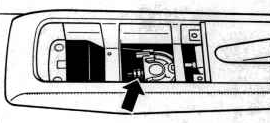On a 993 six-speed or really any 964 or earlier 911, the parking lever is used every time the car is parked. As the parking brake shoes wear over many years, the lever must be raised farther in its travel to lock the parking brake. As the lever requires a longer pull, it becomes ergonomically harder to raise, and the mechanical leverage it applies to the parking brake seems to diminish.
The parking brake, when properly adjusted, takes a lot of upper-body strength to engage it to the point that it holds the car stationary on a hill. When out of adjustment, the force required to set the brake can be so great that most folks can't adequately set the brake lever so it holds on a hill, and releasing it in such situations becomes very difficult.
Turns out adjusting the parking brake lever is very easy:
First, one removes the back top section of the between-the-seat console. If your car has the plain cup, labeled "10" in the illustration below, just remove the rubber pad in the bottom of the cup and unscrew the two Phillips screws to release it. It takes a little jiggling of the cup back and forth to allow it to come free. If your car has one of the optional Tape or CD holders, the screws are still there, but it will take a little investigation to see how to release the holders to get to them. I do not have either of these in my car.
Once the cup is removed, it exposes the cable saddle, labeled "24" in the above illustration, attached to the brake lever and the two cables leading to the rear brakes. There are two nuts: one to adjust the take-up slack on the cables at the wheel ends, the other a jam nut against it to hold it from slipping.
 |
| Jam & Adjusting nut location. |
Release the adjusting nut from the jam nut using two open-end box wrenches. As you tighten up the adjustment nut, trial pull on the brake lever. In my case, I tightened it up to the point where when the lever's ratchet clicked 4 times, I began to feel some resistance from the brake cables through the lever. The key here is to NOT tighten the nut too much, so the parking brake is always partially engaged, as this will create heat in the rear wheel hubs and wear the brake shoe linings, both very undesirable conditions.
Once adjusted, re-snug the jam nut against the adjusting nut and button things up. It took me all of five minutes to do this adjustment.
Adjusting the Emergency/Parking Brake after replacing the brake shoes:
The brake shoes are extremely long-wearing. I checked mine on my previous '86 Carrera at 150K miles and found they still had plenty of lining. However, if one is going to replace the parking brake shoes or simply wants to readjust the shoe clearance at the wheel ends when the wheels are off for other reasons, here is the factory document on how to adjust them:
 |
| Here is the adjusting star wheel (blue arrow) shown with the rotor removed. |
 |
| On the unmounted rotor, note the hole at the 8:30 position in the photo. This is for access to the parking brake adjustment. |
For the right-hand side of the car: (passenger side on USA-delivered cars), rotate the rotor so the adjusting hole in the rotor is at 8:10 as in the hour hand position on a clock, then insert the screwdriver in the hole and rotate the starwheel by moving the screwdriver left-to-right to snug up the brake shoe.
For the left-hand side of the car: (passenger side on USA-delivered cars), rotate the rotor so the adjusting hole in the rotor is at 3:40 as in the hour hand position on a clock, then insert the screwdriver in the hole and rotate the starwheel by moving the screwdriver right to left to snug up the brake shoe.
If you found this page informative, return to the main page and bookmark it for future 993-related servicing, repair, and upgrading guidance & information. If it saved you some time, aggravation, or even some coin, consider donating through the button in the top left corner of this page.
#handbrake
#parkingbrake
#brake
#brakes









